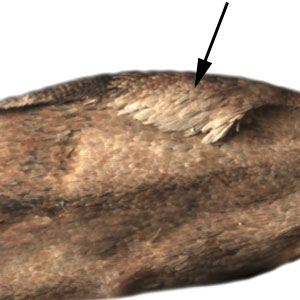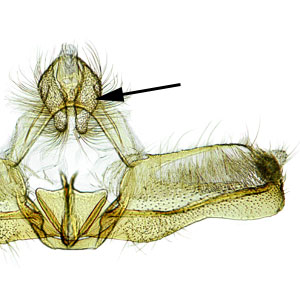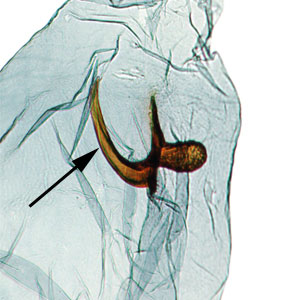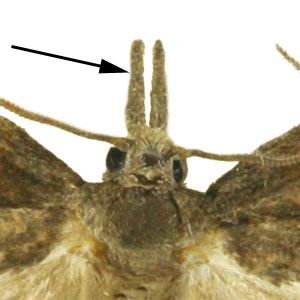Native
Exotic
Platynota Clemens (Tortricidae: Tortricinae: Sparganothini)
The genus Platynota contains approximately 35 described species. The highest species diversity is in the Neotropics, although a few species are described from the northern U.S. and Canada. Adults are sexually dimorphic and wing pattern varies throughout the genus. The forewings of many males are dark brown basally and golden or yellowish brown apically. Female forewings are usually uniformly brown or yellowish brown with dark brown markings. Males have a forewing costal foldforewing costal fold:
a flap or fold at the base of the forewing that contains specialized sex scales . Both sexes often have patches of raised scales on the forewings.
. Both sexes often have patches of raised scales on the forewings.
Male genitalia are characterized by a long thin uncusuncus:
a sclerotized process which is fused to the posterodorsal margin of tergum IX , long, fingerlike sociisocii:
, long, fingerlike sociisocii:
a pair of lightly sclerotized setose lobes , and elongate subrectangular valvaevalvae:
, and elongate subrectangular valvaevalvae:
plural of "valva" . Female genitalia are characterized by a bandlike sterigmasterigma:
. Female genitalia are characterized by a bandlike sterigmasterigma:
the sclerotized region surrounding the female ostium bursae  and a variably-shaped signumsignum:
and a variably-shaped signumsignum:
a sclerotized projection or patch on the interior of the corpus bursae in some species. Labial palpilabial palpi:
in some species. Labial palpilabial palpi:
a pair of sensory appendages that project from the lower part of the head; usually covered in scales and three-segmented are elongate in most species.
are elongate in most species.
Three of the six species treated here, P. flavedana, P. idaeusalis, and P. stultana, are pests of various crops, including apple, citrus, grape, peach, pepper, rose, and strawberry. Larvae are highly polyphagous and some species, such as P. stultana, have been recorded feeding on plants in more than 20 families. The six species included here are the most common Platynota in the continental United States. Two of these (P. rostrana and P. stultana) have been accidentally introduced to Hawaii. For photos of additional non-targets not covered here, visit the Moth Photographers Group link below.
Larvae of Platynota are commonly intercepted at U.S. ports of entry on peppers (Capsicum) from the Caribbean and Mexico, and apple (Malus), basil (Ocimum), rose (Rosa), and Rubus from Central and South America. Larvae are difficult to identity using only morphology, and most identifications are based on a host/origin association. Larvae of Platynota may be confused with those of Argyrotaenia, other Archipini, or other Sparganothini.
Native species
Platynota exasperatana
Platynota flavedana
Platynota idaeusalis
Platynota labiosana
Platynota rostrana
View full screen host table here
Additional photos and distribution maps for species in the United States and Canada are available at Moth Photographers Group.